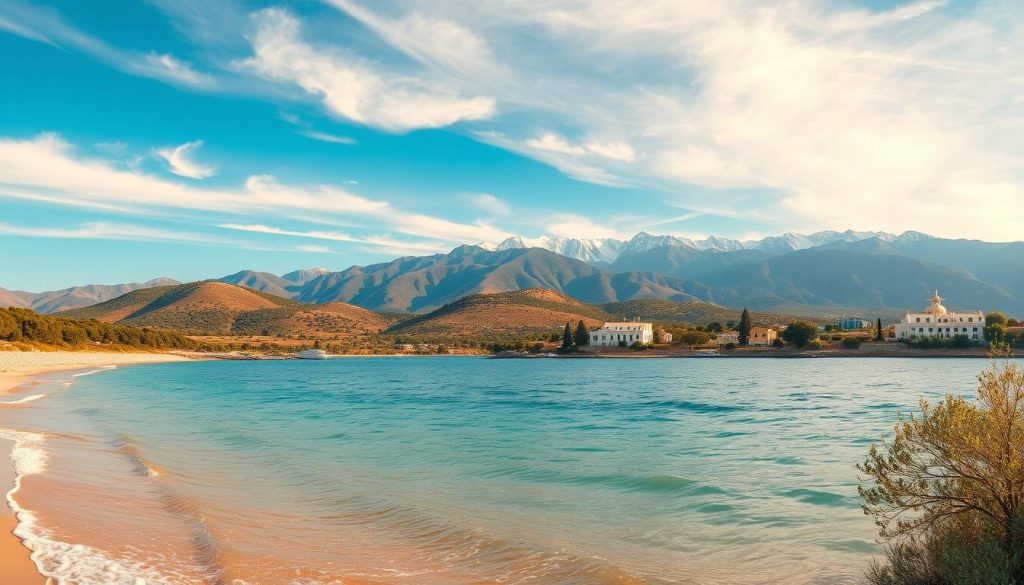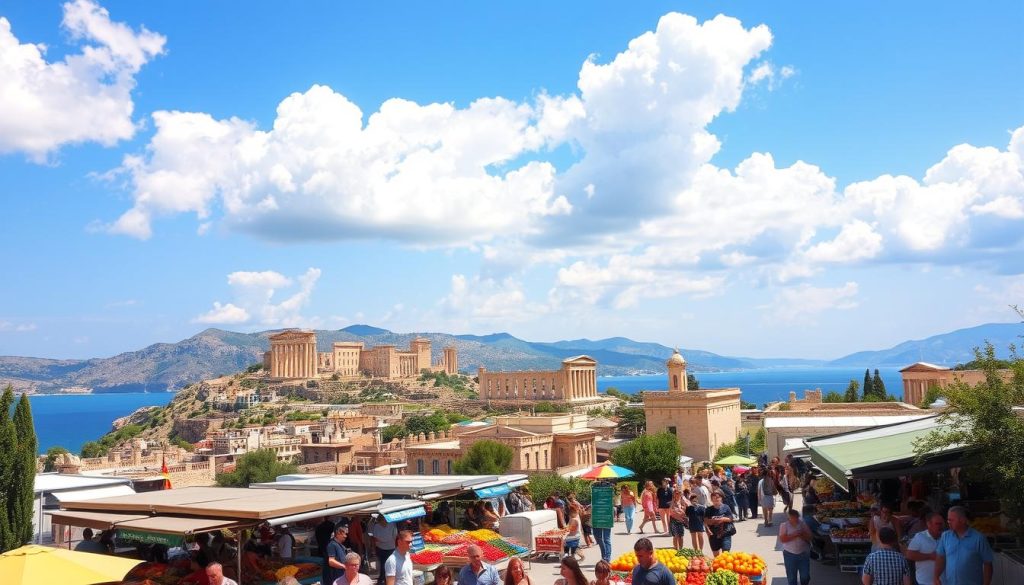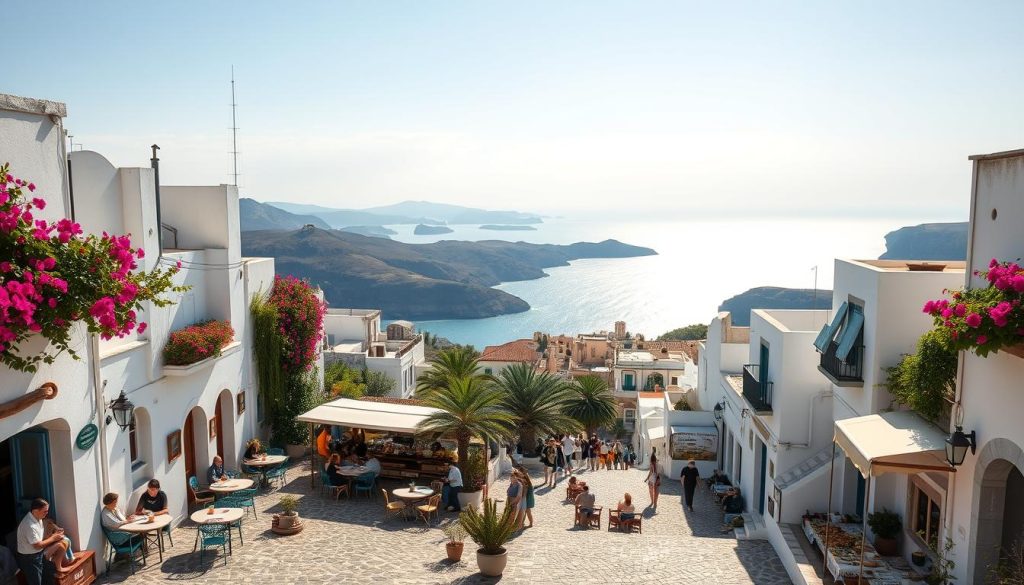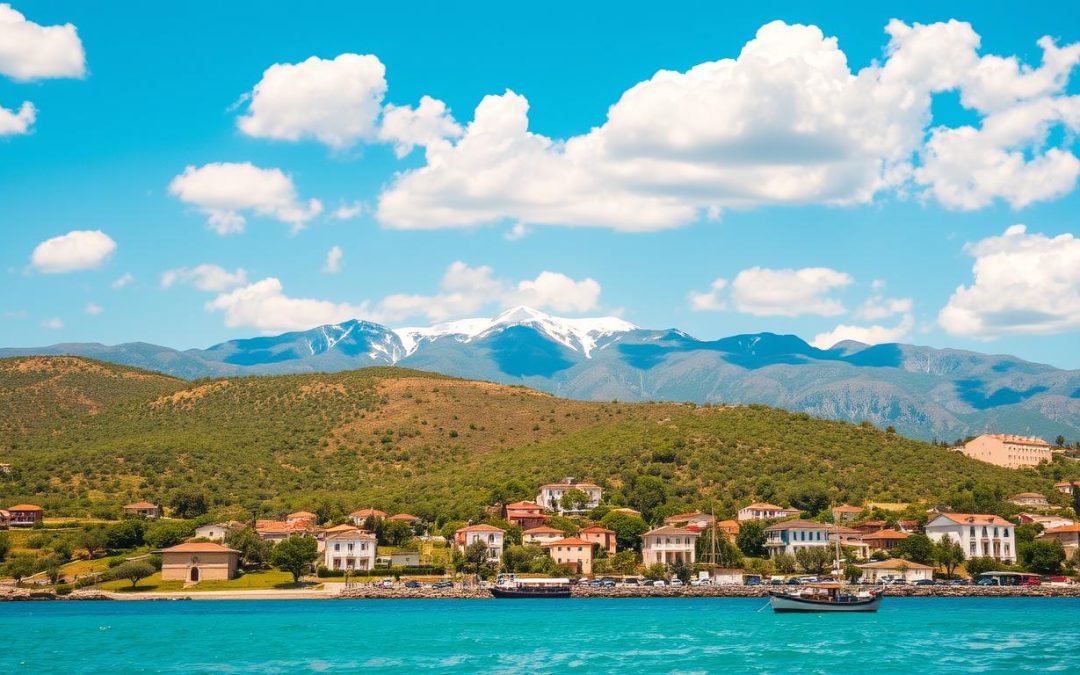Have you ever wondered when the perfect time is to visit a destination known for its sunny skies and stunning landscapes? Timing your trip can make all the difference, especially when it comes to enjoying the Mediterranean charm of Greece.
With its warm, inviting climate, Greece offers something for everyone. Whether you’re dreaming of relaxing on sandy beaches or exploring ancient ruins, knowing the right season to visit can enhance your experience. This guide will help you navigate the weather patterns and local events to plan your ideal getaway.
From the bustling summer months to the quieter, cooler periods, each time of year has its unique appeal. Discover how to make the most of your visit by choosing the best time for your preferred activities. Let’s dive into what makes each month special in this beautiful country.
Key Takeaways
- Plan your trip around the Mediterranean climate for the best experience.
- Different seasons offer unique activities, from beach days to sightseeing.
- Understanding weather patterns helps avoid crowds and high prices.
- Local festivals and events can add a cultural touch to your visit.
- Timing is key to enjoying Greece’s natural beauty and historical sites.
Understanding Greece’s Mediterranean Climate
Understanding the Mediterranean climate can transform your travel experience. This region is known for its mild, wet winters and hot, dry summers. The weather patterns create a perfect balance for both relaxation and adventure.
In the southern parts of the country, winters are mild, with average temperatures around 50°F (10°C). Summers are warm, often exceeding 100°F (38°C). The northern regions, however, can be cooler, with occasional snowfall in winter.
Overview of Weather Patterns
The Mediterranean climate is characterized by distinct seasons. Spring brings mild temperatures, averaging 57°F (14°C) to 77°F (25°C). Summer heats up, with highs often reaching 100°F (38°C). Autumn offers comfortable weather, while winter remains mild in the south.
Rainfall varies across the country. Southern areas like Santorini receive little rain, while Athens sees more during fall and winter. Understanding these patterns helps you plan activities and pack appropriately.
Regional Variations and What They Mean for You
Greece’s climate varies significantly by region. The northern areas, like Thessaloniki, experience colder winters, sometimes with snow. In contrast, the southern islands enjoy milder winters and warmer summers.
These differences impact your travel plans. For example, the northern regions are ideal for winter sports, while the southern islands are perfect for beach activities. Knowing these variations ensures you choose the right destination for your preferences.
| Region | Winter Temperature | Summer Temperature |
|---|---|---|
| Northern Greece | 32°F (0°C) – 50°F (10°C) | 75°F (24°C) – 90°F (32°C) |
| Southern Greece | 50°F (10°C) – 60°F (16°C) | 90°F (32°C) – 100°F (38°C) |
Whether you’re exploring ancient ruins or relaxing by the sea, understanding the climate ensures a smooth and enjoyable trip. Plan wisely to make the most of your time in this beautiful country.
Month-by-Month Guide: Greece: Best Months for a Weather-Savvy Trip
Each month offers unique experiences, depending on what you’re looking for. From blooming wildflowers in spring to quieter beaches in autumn, timing your visit can enhance your trip. Let’s explore what each season has to offer.

Spring & Early Summer Insights
Spring is a magical time to visit. March and April bring mild temperatures, averaging 57°F (14°C) to 68°F (20°C). Wildflowers bloom, and the countryside is lush and green. It’s perfect for hiking and exploring ancient ruins without the summer crowds.
May and June mark the start of early summer. Temperatures rise to 77°F (25°C), making it ideal for sightseeing. The sea begins to warm up, and island weather is pleasant for swimming. This is the best time visit for those who enjoy a mix of activities and fewer tourists.
Peak Summer Analysis
July and August are the hottest months, with temperatures often exceeding 90°F (32°C). The islands buzz with energy, and beaches are at their liveliest. Sea temperatures are warm, perfect for swimming and water sports.
However, this is also the busiest time. If you prefer a quieter experience, consider visiting in late August. The weather remains warm, but crowds start to thin out as summer winds down.
Autumn and Winter Perspectives
September and October are ideal for those who enjoy pleasant weather without the summer heat. Temperatures range from 68°F (20°C) to 77°F (25°C). The sea is still warm, and island weather is perfect for swimming. Early September also hosts local festivals, adding a cultural touch to your trip.
November and December bring cooler temperatures, averaging 50°F (10°C) to 60°F (16°C). Winter is quieter, with fewer tourists and lower prices. While the weather can be unpredictable, it’s a great time to explore historical sites and enjoy the local culture without the crowds.
Seasonal Attractions and Activities in Greece
From outdoor adventures to cultural celebrations, Greece offers something for every traveler. Each season brings unique opportunities to explore, celebrate, and immerse yourself in the local culture. Whether you’re hiking through lush landscapes or joining a lively festival, there’s always an activity to enjoy.

Outdoor Adventures and Cultural Events
Spring and early summer are perfect for outdoor activities. Hiking trails bloom with wildflowers, and the weather is ideal for exploring ancient ruins. The islands offer sailing opportunities, while the mainland’s mountains invite climbers and nature lovers.
Summer is all about the beaches. Warm sea temperatures make swimming and water sports a must. Autumn brings cooler weather, perfect for vineyard tours and olive harvests. Winter, though quieter, offers unique experiences like exploring historical sites with fewer crowds.
Festivals, Feasts, and Local Celebrations
Greece’s cultural calendar is packed with celebrations. The Armata Festival in Spetses is a maritime spectacle, while the Corfu Beer Festival in September celebrates the harvest season. Religious feast days, like Easter, are marked with traditional foods and music.
Island life shines during these events. From Santorini to Crete, each island has its own unique traditions. Even in winter, local festivals keep the spirit alive, offering a glimpse into Greece’s rich heritage.
- Spring: Hiking, wildflower trails, and ancient ruins.
- Summer: Beach days, water sports, and lively festivals.
- Autumn: Vineyard tours, olive harvests, and cultural events.
- Winter: Historical site visits and local celebrations.
No matter when you visit, Greece’s attractions and celebrations ensure every day is memorable. Plan your trip around these seasonal highlights to make the most of your adventure.
Top Destinations in Greece: Athens, Santorini and More
Exploring Greece’s top destinations offers a mix of history, beauty, and adventure. From bustling cities to serene islands, each place has its own charm. Whether you’re drawn to ancient ruins or stunning landscapes, there’s something for every traveler.

Athens: History, Heat, and Hidden Gems
Athens is a vibrant city that blends ancient history with modern energy. Home to iconic landmarks like the Acropolis and Parthenon, it’s a must-visit for history enthusiasts. Summers here can be hot, with temperatures often exceeding 100°F (38°C).
Beyond the famous sites, hidden gems await. Explore the charming neighborhoods of Plaka and Monastiraki for local shops and cafes. The National Archaeological Museum offers a deeper dive into Greece’s rich past. Plan your visit during spring or autumn for milder weather and fewer crowds.
Island Highlights: Santorini, Crete, and Thriving Mainland Spots
Santorini is a dream destination with its whitewashed buildings and stunning sunsets. Its semi-arid climate makes it perfect for summer visits. Enjoy the beaches, explore the caldera, or indulge in local wines. For a quieter experience, visit in late spring or early autumn.
Crete, the largest island, offers a mix of history and natural beauty. The Palace of Knossos and Samaria Gorge are must-sees. Winters here are mild, making it a great year-round destination. Don’t miss the local cuisine, known for its fresh ingredients and unique flavors.
The mainland also has much to offer. Delphi, a UNESCO World Heritage Site, is a treasure trove of ancient history. Meteora’s monasteries, perched on rock pillars, are both spiritual and awe-inspiring. These spots are ideal for those seeking a blend of culture and adventure.
- Athens: A bustling capital with iconic landmarks and hidden gems.
- Santorini: Famous for its architecture, sunsets, and ideal summer weather.
- Crete: Rich in history, natural beauty, and mild winters.
- Mainland spots: Delphi and Meteora offer unique cultural and spiritual experiences.
Each city and island in Greece offers a unique window into the country’s culture and climate. Plan your visit based on seasonal trends and the type of experience you seek. Whether you’re a history buff, nature lover, or beach enthusiast, Greece has it all.
Travel Tips for Your Weather-Savvy Greek Trip
Traveling to Greece? These tips will help you navigate the weather and crowds. Whether you’re planning a summer getaway or a quiet autumn retreat, being prepared ensures a smoother experience. From packing essentials to avoiding peak crowds, here’s everything you need to know.

Packing Essentials and What to Wear
Packing for Greece depends on the season. Summers are hot, so lightweight clothing, sunscreen, and a wide-brimmed hat are must-haves. Don’t forget your swimwear for the warm water at the beach.
For cooler evenings, especially in spring or autumn, pack a light sweater or jacket. Comfortable walking shoes are essential for exploring historic sites and uneven terrains. A versatile day bag can carry your essentials while you’re out and about.
- Lightweight clothing for summer heat.
- Layered options for cooler evenings.
- Comfortable shoes for walking and hiking.
- Swimwear and a quick-dry cover-up.
Navigating Crowds, Lower Prices, and Transportation
To avoid crowds, consider traveling during the shoulder seasons—spring or autumn. These periods offer pleasant weather and lower prices on accommodations and flights. Plus, you’ll have more space to enjoy popular sites.
Transportation can get busy during peak seasons. Book ferries and flights in advance, especially if you’re island-hopping. In off-peak months, schedules may be reduced, so plan accordingly. Keep an eye on weather forecasts to adjust your daily plans and packing list.
| Season | Crowd Level | Price Range |
|---|---|---|
| Summer (June-August) | High | High |
| Spring (April-May) | Medium | Medium |
| Autumn (September-October) | Low | Medium |
By following these tips, you can make the most of your trip, whether you’re soaking up the sun on a beach or exploring ancient ruins. Plan ahead, pack smart, and enjoy your adventure!
Conclusion
Planning your visit around the right season can make all the difference. Whether you’re drawn to sunny beach days or cooler explorations, there’s a perfect time for your trip. From the vibrant energy of summer to the serene charm of winter, each period offers unique experiences.
Use the month-by-month guide to craft your itinerary. Balancing weather and crowd levels ensures a smoother journey. Shoulder seasons like spring and fall often provide pleasant temperatures and lower prices, making them ideal for many travelers.
Don’t forget the travel tips shared earlier. Pack smart, book in advance, and stay weather-savvy to maximize comfort and savings. Understanding these details can turn an ordinary vacation into an extraordinary adventure.
Ready to explore? Plan ahead to enjoy the very best of this beautiful destination—from bustling cities to tranquil islands. Have questions or need more details? Feel free to ask!
The above is subject to change.
Check back often to TRAVEL.COM for the latest travel tips and deals.
Here are some Tours & Sightseeing suggestions that might pique your interests!
